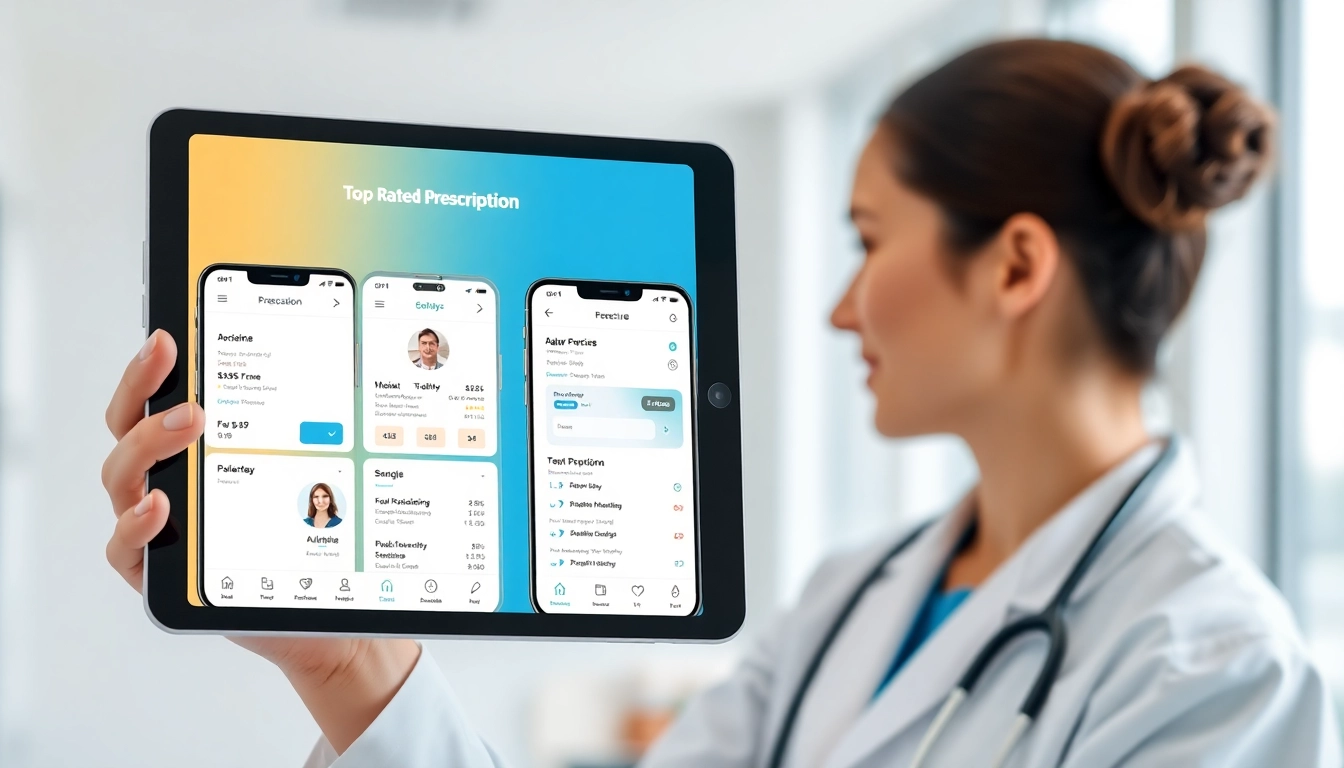Understanding the Importance of Free Eprescription Apps
In the rapidly evolving landscape of healthcare technology, e-prescription apps have emerged as transformative tools that streamline the prescribing process, ultimately enhancing patient care. These applications facilitate the electronic transmission of prescriptions directly to pharmacies, replacing the traditional paper-based method with a modernized solution that prioritizes efficiency and accuracy. In this digital age, utilizing free eprescription apps is not just an option but increasingly a necessity for healthcare providers aiming to improve patient outcomes and operational workflows.
What Are Eprescription Apps?
Eprescription apps are digital platforms that enable healthcare providers to prescribe medication electronically. These apps allow physicians to create, manage, and send prescriptions directly from their devices—including smartphones, tablets, and computers—to pharmacies. Eprescription apps may also integrate with Electronic Health Record (EHR) systems, providing a seamless flow of patient information, which cuts down on errors and miscommunications. Through these platforms, providers can check for drug interactions, view patient medication histories, and access up-to-date formulary information, ensuring informed prescribing practices.
Benefits of Using Eprescription Apps
The advantages of adopting e-prescribing technology are manifold and can significantly impact both provider workflows and patient experiences:
- Enhanced Efficiency: Eprescription apps eliminate the need for manual handwriting and phone calls to pharmacies, dramatically reducing the time spent on prescription management.
- Increased Accuracy: By minimizing human errors associated with handwritten prescriptions, these apps help ensure that patients receive the correct medications and dosages.
- Improved Safety: Eprescribing can alert providers to potential drug interactions, allergies, or contraindications via integrated databases, leading to safer prescribing practices.
- Better Patient Engagement: Many e-prescribing platforms enable providers to communicate directly with patients about their medications and provide educational resources.
- Cost Effectiveness: Free e-prescription solutions allow healthcare practices, especially smaller ones, to adopt modern technology without incurring significant costs.
Challenges in Traditional Prescription Methods
Despite these advantages, traditional prescription methods have posed numerous challenges that can compromise patient safety and provider efficiency:
- Illegible Handwriting: Prescriptions written by hand can often be misread by pharmacists, leading to potentially harmful medication errors.
- Time-Consuming Communication: Long phone calls and follow-ups between providers and pharmacies can delay treatment and frustrate patients.
- Data Inconsistencies: Manual processes can result in loss or confusion of patient data, particularly if prescriptions need to be modified.
- Dependence on Paper: In a digital world, reliance on paper for prescriptions is both outdated and inefficient, opening avenues for lost documents.
Top Features of Free Eprescription Apps
Ease of Use and Accessibility
A key advantage of free e-prescription apps is their user-friendly design. Most applications feature intuitive interfaces that require minimal training for healthcare providers. Whether on a desktop or mobile device, providers can quickly access patient data and prescription history at their fingertips, allowing for a more straightforward prescribing process. Additionally, many apps offer cloud storage options, enabling users to access their accounts from different devices, promoting flexibility and continuity of care.
Integration with Medical Systems
Integration capabilities with existing practice management and EHR systems are vital for the successful adoption of e-prescribing solutions. Many free e-prescribing apps can synchronize with healthcare providers’ electronic systems, enabling seamless updates to patient records, medication histories, and appointment schedules. This interoperability reduces the duplication of effort, as healthcare providers can enter data once in their system, ensuring accuracy and consistency across platforms.
Security and Compliance Considerations
Security is paramount when dealing with patient data. Free e-prescription apps are designed to comply with industry regulations, including HIPAA, ensuring that patient information is safeguarded against unauthorized access. This often includes features such as end-to-end encryption for data in transit, secure user authentication processes, and regular audits to maintain compliance. By leveraging such apps, healthcare providers can focus on their patients without compromising on security.
How to Choose the Right Free Eprescription App
Assessing User Reviews and Ratings
When selecting a free e-prescription app, it is crucial to consider user feedback. Healthcare providers should review ratings and comments from users on app stores and professional forums. High ratings and positive testimonials generally indicate a reliable application, while consistent complaints about issues can be a red flag. Engaging with community discussions and reviews can provide valuable insights into how the app performs in real-world scenarios.
Compatibility with Your Practice Management Software
Before committing to an e-prescribing app, healthcare providers must assess its compatibility with existing practice management systems. The ability to integrate smoothly can significantly enhance efficiency and workflow. Providers should confirm that the e-prescription app can communicate with their current software, minimizing disruptions during the transition. This consideration will help avoid potential issues later with data entry and patient record management.
Trial Periods and Features Exploration
Many e-prescription service providers offer trial periods or demo versions of their apps. Healthcare providers should take advantage of these offers to explore the features and functions of the software. During the trial, it is beneficial to evaluate user interfaces, backup options, and customer support service. This hands-on experience will inform providers about the app’s usability and whether its features align with their unique practice needs.
Implementing Free Eprescription Apps in Your Practice
Steps for Smooth Implementation
Successful implementation of free e-prescription apps requires methodical planning and execution. Here are key steps for a seamless transition:
- Staff Training: Provide thorough training sessions for all relevant staff members to ensure they understand how to use the app effectively.
- Data Migration: Safely transfer existing patient and prescription data into the new system, ensuring accuracy and completeness.
- Set Up User Accounts: Create individual user accounts for providers and staff, establishing different access levels for security.
- Test the System: Before fully transitioning to the app, conduct tests to ensure all functionalities perform correctly.
- Feedback Collection: Once in use, gather feedback from staff and providers to identify potential issues early on.
Training Staff and Providers
Training is a critical component for the successful adoption of any new technology. It is essential to develop a comprehensive training program that addresses not only the mechanics of using the e-prescription app but also best practices for its effective implementation. Consider organizing workshops or online seminars, which allow users to ask questions and learn through hands-on practice. Providing ongoing support and accessible tutorials will help users feel more comfortable with the new system and maximize its benefits.
Monitoring and Improving User Experience
Once the free e-prescription app is implemented, monitoring its usage is imperative for continuous improvement. Regularly seek input from staff and providers to identify pain points or challenges experienced while using the app. Creating forums for discussion or anonymous feedback tools can help gather candid insights. Based on this feedback, necessary adjustments can be made to the workflows or additional training can be offered to enhance user satisfaction and efficiency.
Measuring the Impact of Eprescription Apps
Key Performance Indicators (KPIs) to Track
To assess the effectiveness of e-prescribing in your practice, it is essential to establish and track key performance indicators (KPIs). Some KPIs to consider include:
- Prescription Accuracy Rates: Measure the number of errors or miscommunications associated with prescriptions before and after implementing the app.
- Prescription Fulfillment Rates: Track the percentage of prescriptions filled at pharmacies compared to those sent, identifying any potential drop-off points.
- Time Savings: Analyze how e-prescribing has reduced the time spent creating and managing prescriptions.
- Patient Satisfaction Surveys: Regularly capture patient feedback regarding their experience with prescriptions and overall satisfaction with care.
Gathering Feedback from Patients and Staff
Gathering insights from both patients and staff can provide a comprehensive view of the app’s performance. Conduct surveys and feedback sessions periodically to understand their experiences better. Consider questions that address the ease of use, wait times, and available support. This feedback is invaluable for identifying areas for improvement and ensuring that the e-prescribing solution meets the needs of both the practice and its patients.
Long-term Benefits of Digital Prescription Practices
Embracing digital prescription practices through the use of free e-prescription apps can yield numerous long-term benefits, including:
- Improved Patient Outcomes: Enhanced accuracy and communication lead to better medication management, contributing to improved health outcomes.
- Streamlined Administrative Processes: Reduced paperwork and improved workflows minimize administrative burdens for healthcare providers.
- Cost Savings: Over time, practices can save on costs related to paper, printing, and administrative errors by transitioning to digital methods.
- Resilience and Continuity: Digital methods help practices remain agile and responsive in face of challenges, such as natural disasters or pandemics.



